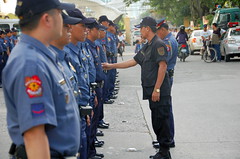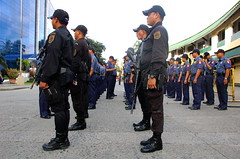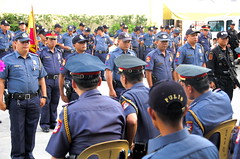Police Services
Building Resources


The Philippine National Police Headquarters, Station 3 is located within the City Hall Compound, housed in a four-level building complex together with the local Fire Department and the City Jail. Its area of jurisdiction covers the entire City of Mandaluyong.
For a more efficient delivery of protective services, five (5) community precincts (Table 5.26) are established in strategic locations in the city, each covering a different group of barangays, as can be seen in Map 54. Each precinct is provided with well-maintained service vehicles and equipment as listed in Table 5.27.
Manpower
Total size of the police force is 301, composed of 265 non-commissioned officers, 20 officers and 16 civilian employees. This gives a police-population ratio of 1:925 which is below the standard for highly-urbanized areas.






The force is augmented by 489 civilian employees under the Public Order and Safety Division and the Mayor’s Action Command of the city government.
In addition, the Force has accredited a total of 34 private agencies that provide private security and detective services. These are listed in the proceeding Table 5.28.
Crime Statistics
Report from the Philippine National Police reveals that the city enjoys a relatively peaceful community. Crime Solution Efficiency for the past four years registered a high of 96.39% in year 2000 and a low of 94.31% for the current year. The figure for the current year however, is only inclusive of January to May 2003.
Theft and physical injury are among the top index crimes committed in the city.
Fire Protection
A. Building Resources
The city is protected from fire incidences by the Mandaluyong Fire Station, with its Head Office and Central Sub-Fire Station housed at the PNP/Fire/Jail Complex, City Hall Compound.
The Central Sub-Fire Station has citywide area coverage, and is augmented by the EDSA Central Substation which covers barangays in the vicinity of EDSA, and the Kalentong Substation which serves barangays to the left of the PNR Railroad Track, as can be seen in Map 55.
B. Manpower Resources
There are four (4) major divisions that comprise the overall operation of the fire department. Table 5.30 shows the distribution of personnel, 83 in all, of which about 55 percent man the central station at the city hall.


Table 5.30
Distribution of Fire Personnel
| Division | No. of Personnel |
|---|---|
| Administrative | 8 |
| Inspection | 7 |
| Operation | |
| – Central Fire Station | 46 |
| – EDSA Central Substation | 9 |
| – Gen. Kalentong Substation | 7 |
| – Fire Rescue | 6 |
| TOTAL | 83 |
This gives a Fireman-population ratio of 1:3,355
Size and area coverage of fire substations are shown in Table 5.31.
C. Fire Trucks and Rescue Equipment
There are only three (3) fire trucks available for operation in the city. This is augmented by three (3) more water tankers and another three (3) water pumpers during fire emergencies. Two (2) ambulances for rescue operations are in stand-by. Other fire facilities include mobile radios for communication purposes.
Compared to the previous years, the current quantity of fire trucks has decreased from the recorded four (4) in 2000 to a three (3) this year. This leaves one fire truck for each sub-station. (see Table 5.32)
TABLE 5.32
Inventory of Equipment and Facilities
| Facilities | Quantity | Status | Function |
|---|---|---|---|
| Fire trucks | 4 | 3 operational 1 non-operational | Fire Operation Water Supply Other Emergencies |
| Water tankers | 3 | All operational | Fire Operation Water Supply |
| Ambulance | 2 | All operational | Rescue Transport of Patient |
| Water Pumpers | 3 | All operational | Water supply |
| Mobile/Base/ Handheld Radio | 8 2 | All operational | Communications |
| Source: City Fire Department Report | |||
D. Fire Hydrants
A total of 78 fire hydrants distributed all over the city supplement the firefighting facilities. Of these, 60 are operational and 16 as non-operational.
Fire Incidence Statistics
With figures of fire incidences for years 2000-2002, fire occurrence averages at 254.33 annually. This seems to be a high frequency considering the size of the city. However, it can be attributed to the proliferation of informal settlements in various barangays.
These fire incidences are mostly rubbish and structural in nature, with origins varying from electrical, cigarette butts, LPG (Tank/Stove) to unknown sources as can be seen in Table 5.33.
Table 5.33
Fire Incidence Report 2000-2003
| Incidence | Year 2000 | Year 2001 | Year 2002 |
|---|---|---|---|
| Structural | 65 | 54 | 64 |
| Electrical | 87 | 108 | 92 |
| Vehicular | 6 | 17 | 15 |
| Rubbish | 32 | 21 | 32 |
| Others | 46 | 65 | 59 |
| TOTAL | 236 | 265 | 262 |
| Source: City Fire Department Report | |||
Fire Safety Prevention Measures
A. Fire Safety Inspections
One measure to prevent fire occurrences is the continuous conduct of fire safety inspections in different establishments in the city. As shown in Table 5.31, inspections conducted in year 2000 increased by 1.78% from 1999 inspections. Fewer establishments in year 2000 were found to have deficiencies in fire safety requirements and subsequently recommended for correction and improvement. Consequently, a total of 301 Fire Safety Inspection Certificates were issued, a 24.38% increase compared to the 242 certificates issued in 1999.
B. Community Relations
Another preventive measure is maintaining Community Relations. As a result, more fire drills were conducted and more volunteers trained in this year as can be seen in Table 5.32. At the same time, 300 empty drums were distributed to serve as stand-by water containers in cases of emergencies.
Problems and Needs
Mandaluyong City is adequately provided with fire station facilities considering that the three (3) existing fire substations located as shown in Map 55 have overlapping radii of services.
Based on standards, one fire substation should be within a radius of 2.5 km., 5 km. and 10 km. from commercial-industrial areas, medium to high density residential areas, and low density residential areas, respectively. The city is mostly medium to high density residential with commercial strips and has a total land area of 11.25 sq. km., well within the coverage of one fire substation.
In addition, the city is adequately served with roads such that the ideal travel time of two (2) minutes from the station to the fire can be achieved. There are, however, certain problems that have to be addressed for a more efficient fire fighting service.
A. Delayed Response
Despite adequacy of roads and relatively short distances between fire substations and the sites on fire, there are instances when fire trucks are delayed due to traffic congestion in some areas and the negative attitude of drivers particularly of public utility vehicles to pull over the side of the road and give way to fire trucks and other vehicles responding to the emergency calls. An additional of one (1) to two (2) minutes of travel time would certainly result to greater damages which road users must be made aware of.
B. Preventable Causes of Fire
Based on the Fire Incidence Report, causes of most fires such as discarded glowing cigarette butts, leaking gas tanks, and faulty electrical wiring, are preventable in nature and resulting from carelessness, negligence, or ignorance of the individual who caused the fire.
C. Very Low Fireman-Population Ratio
By standards, the fireman-population ratio should be at least 1 : 500 for urban/metropolitan areas. In actual, the City of Mandaluyong has a ratio of 1 : 3,355 which means that one fireman has 3,355 people under his protection, almost seven (7) times that of the standard.
D. Insufficient Fire Fighting Facilities
By standard area coverage, the existing three substations are more than sufficient to serve the entire city. However there are factors that suggest the need for additional fire substations, to wit;
- Existing substations are not sufficient to accommodate increase in fire-fighting personnel and apparatus/fire trucks
- Influx of people and increase in building density as a consequence of intensification of land uses/activities pursuant to the approved Comprehensive Land Use Plan of the City.

